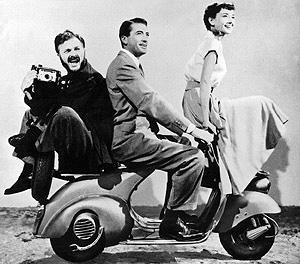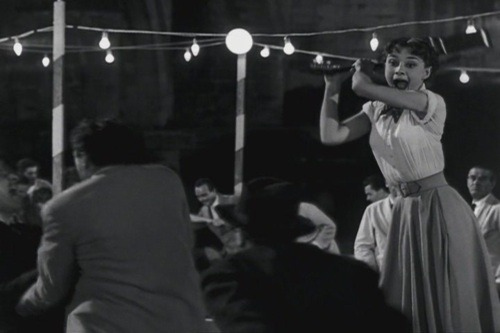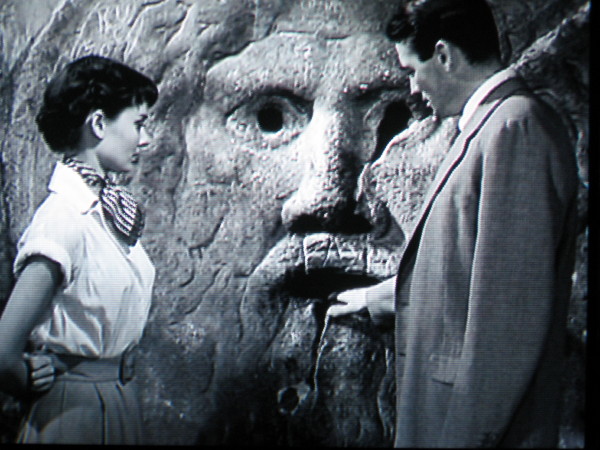 |
| Look, Ma, no license! |
Cinderella has enchanted generations with her rags
to riches story of a commoner who is able to capture the prince of her dreams
in a single meeting. Like her fabled counterpart, unknown actress Audrey
Hepburn was able to capture her audiences’ affections in a single performance
in her American film debut, Roman
Holiday. Hepburn’s reverse-Cinderella portrayal of a princess desperate for
the freedom of common life made her an over night celebrity, and America’s
enduring sweetheart. After the prevalence of hard hearted femme fatales and
world weary heroines that dominated post-war cinema, Americans found the escape
they were looking for in Hepburn’s fresh face and infectious charm. Following
the success of the film, Hollywood ushered in a new kind of femme who, though
far from fatale, was irresistible nonetheless and remains so even in today’s
cynical age.
The film begins as Hepburn’s Princess Ann greets
various dignitaries upon her arrival in Rome. The princess is on the trip in an
effort to promote good will between her unnamed country and the rest of Europe’s
nations. Although she is able to maintain the utmost dignity in her voice and
facial expression, her increasing restlessness is revealed when the camera
moves under her dress while she removes her shoes and attempts to shift her
balance from one aching foot to another . Upon returning to her hotel after the
day’s grueling activities, she is presented with the schedule for the rest of
her trip, which proves to be equally demanding and only adds to her building stress.
When she is denied the right to visit any of the city’s attractions she finally
reaches her breaking point and becomes hysterical. Rather than addressing the cause
of her distress, her aides instead opt for a temporary solution by administering
her a sedative to help her sleep, and sending her to bed like a misbehaving child.
As
soon as she is alone, Ann strikes back by sneaking out of the hotel to the city
streets ,where she promptly passes out on a park bench. Just as the local police
attempt to arrest her for vagrancy, she is rescued by American journalist Joe
Bradley (Gregory Peck) who vouches for her. Bradley mistakes her for a party girl
at the end of a wild night and finally takes her back to his apartment after
several failed slapstick attempts to be rid of her. After sleeping on the couch
while Ann occupies his bed, Joe arrives late for work the next morning only to
realize that not only is she the princess he was assigned to interview, but she
has also been reported missing. He immediately realizes the possibilities that
an exclusive interview with a princess would open to his career and sets about
getting the interview without blowing his cover. Over the course of the next
twenty-four hours, Joe and his friend, photo journalist Irving (Eddie Albert),
accompany Ann on a series of ‘normal’ activities
that quickly escalate into life-altering
adventures. Through these experiences, Ann and Joe find themselves seeing both the
world around them and each other through new eyes and begin to fall in love.
Although the film is in many ways a modern fairy tale, it avoids becoming completely
escapist through a bittersweet, but honest, ending.
 |
| Audrey unleashed! |
Roman
Holiday made film history not only through the meteoric
success of its star, but also through its use of location shoots. Prior to this
film, most American films would be filmed on Hollywood sound stages with stock
footage serving as the background. In Roman
Holiday, however, the background provides the story with a true sense of
setting that lends a sense of realism to the otherwise idyllic tale. Throughout
the film, viewers join Hepburn and Peck on a tour of both the renowned and
private sides of Rome until the city almost becomes a character in its own
right. Such scenes as Peck and Hepburn’s famous motorbike ride and Peck’s “Mouth
of Truth” gag simply would not have had their spontaneity and magic had they
been shot on replicated studio sets rather than their authentic settings. While
the sets grounded the story in real life locations, they also added another layer
of fantasy for the average American audience, for whom this film would likely be
the closest they would ever come to exploring a European capital.
The film’s performances are light, comedic, and
expertly executed to create a true classic. Hepburn perfectly captures the princess’
internal conflict between her duties to her country and her duties to herself. She also
imbues the princess with a mixture of innocence and inquisitiveness that makes
her seem more like the girl next door than an unattainable member of royalty.
Similarly, Peck inhabits his character with an endearing combination of worldly
cynicism and well hidden idealism that makes audiences fall for him along with
the princess. Finally, Albert nearly steals the film with his hilarious turn as
a bohemian photographer.
Roman Holiday marked the beginning of
America’s on-going love affair with star Audrey Hepburn. Prior to the film’s
release, Peck reportedly requested that his co-star’s name be billed above his,
insisting that it wouldn’t look right for him to be billed above a performance that he
was sure would win an Oscar. Peck’s prediction more than came true, as Hepburn
went on to take both the film and fashion industries by storm. As her acting
skills gained notice so too did her unique appearance and sense of style. In response
to the public’s warm reception of Hepburn’s waif-like figure and simple style,
fashion designers quickly began to churn out clothes and advertisements that suited
the ‘Audrey’ look. Hepburn's signature chic quickly replaced the previously dominant frills and curves
associated with stars like Marilyn Monroe. The Audrey look has maintained dominance over the
last sixty years, as is evidenced by the sex symbol status of petite stars such
as Natalie Portman and Keira Knightly. Hepburn later went on to star in
numerous other films including the iconic Breakfast
at Tiffany’s before devoting herself to charity. While she enjoyed her
career as an actress and worked diligently to perfect her craft, her heart was
truly in her work with children’s charities such as UNICEF. She is reported as
crediting her experiences living through Nazi occupation and Allied
liberation in Belgium as her inspiration to give back her good fortune to
children in need.
Through its combination of 50's fantasy and timless romance, Roman Holiday has gone on to become an essential title for both classic and contemporary movie fans. The film reinvigorated the romantic comedy with plot devices and technical details that have since become staples of the genre. The film also launched the now legendary career of star Audrey Hepburn and established co-star Gregory Peck's status as a top leading man. Roman Holiday truly is a must-have for fans of old fashioned romance and those in need of a brief holiday from every-day life.
Through its combination of 50's fantasy and timless romance, Roman Holiday has gone on to become an essential title for both classic and contemporary movie fans. The film reinvigorated the romantic comedy with plot devices and technical details that have since become staples of the genre. The film also launched the now legendary career of star Audrey Hepburn and established co-star Gregory Peck's status as a top leading man. Roman Holiday truly is a must-have for fans of old fashioned romance and those in need of a brief holiday from every-day life.
 |
| You want me to put what, where?! |

This a beloved movie of mine and you captured its essence perfectly.
ReplyDelete